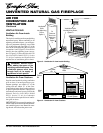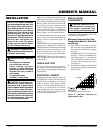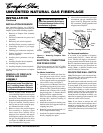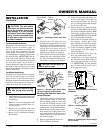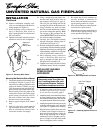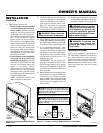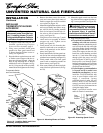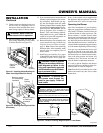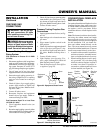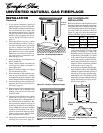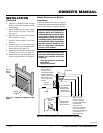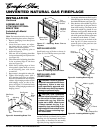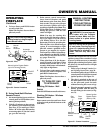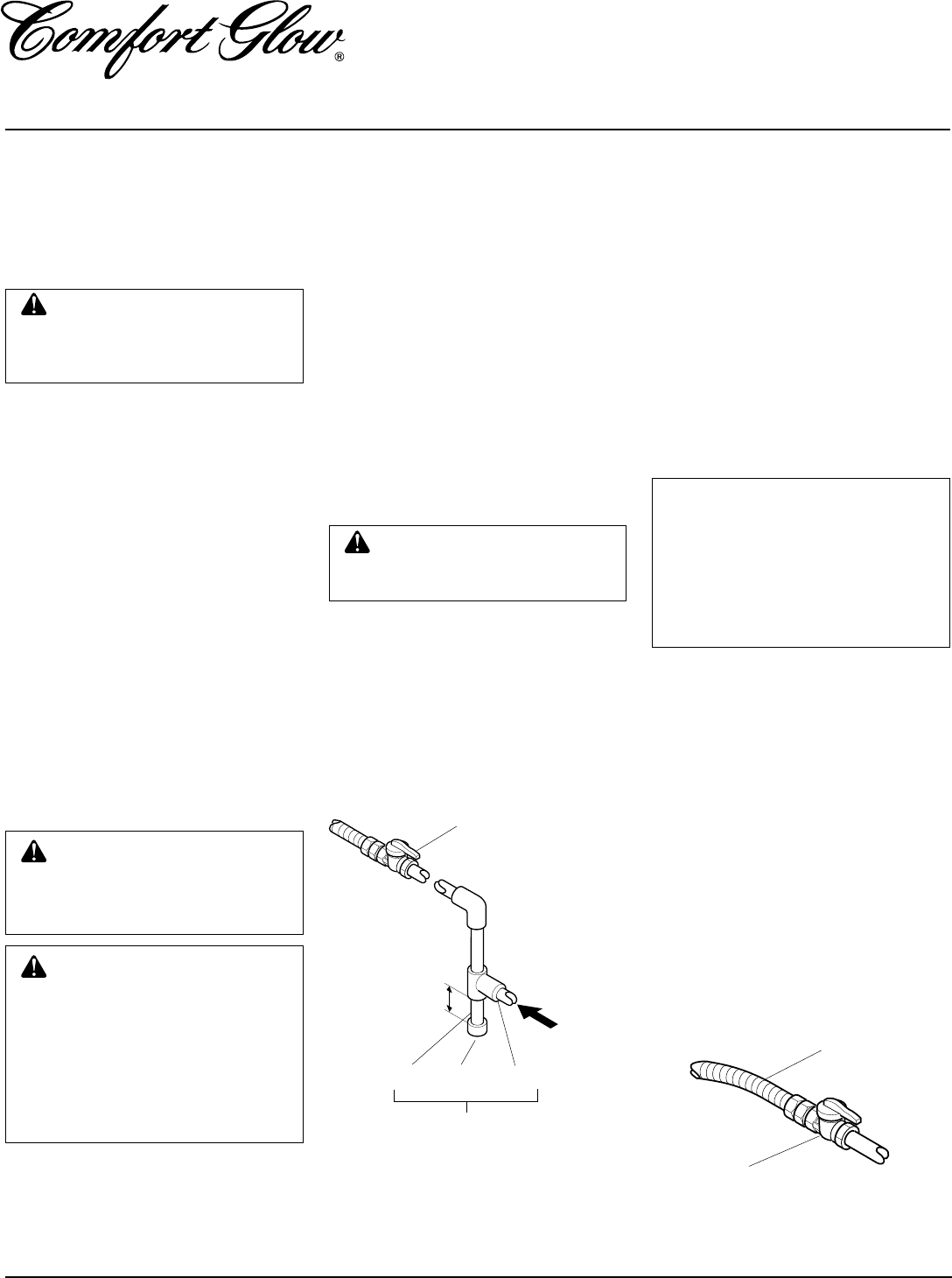
14
107569
UNVENTED NATURAL GAS FIREPLACE
For more information, visit www.desatech.com
From Gas
Meter (5"
W.C. to
10.5" W.C.
Pressure)
Figure 24 - Gas Connection
* Purchase the optional CSA design-certi-
fied equipment shutoff valve from your
dealer. See Accessories, page 34.
CAUTION: Use pipe joint seal-
ant that is resistant to liquid pe-
troleum (LP) gas.
We recommend that you install a sediment trap
in supply line as shown in Figure 24. Locate
sediment trap where it is within reach for clean-
ing. Install in piping system between fuel sup-
ply and fireplace. Locate sediment trap where
trapped matter is not likely to freeze. A sedi-
ment trap traps moisture and contaminants.
This keeps them from going into fireplace gas
controls. If sediment trap is not installed or is
installed wrong, fireplace may not run properly.
INSTALLATION
Continued
Installation must include an equipment
shutoff valve, union, and plugged 1/8" NPT
tap. Locate NPT tap within reach for test
gauge hook up. NPT tap must be upstream
from fireplace (see Figure 24).
IMPORTANT:
Install equipment shutoff
valve in an accessible location. The equip-
ment shutoff valve is for turning on or
shutting off the gas to the appliance.
Check your building codes for any special
requirements for locating equipment shutoff
valve to fireplaces.
Apply pipe joint sealant lightly to male
threads. This will prevent excess sealant
from going into pipe. Excess sealant in pipe
could result in clogged fireplace valves.
Never use sealant on flare threads.
Installation Items Needed
• 5/16" hex socket wrench or nut-driver
• Phillips screwdriver
• sealant (resistant to propane/LP gas, not
provided)
1. If fireplace screen and floor are still
installed, see Removing Fireplace
Screen and Floor Assembly, page 8.
2. Route gas line (provided by installer)
from equipment shutoff valve to fire-
place. Route flexible gas supply line
through one of the access holes.
CONNECTING FIREPLACE
TO GAS SUPPLY
Figure 25 - Attaching Gas Lines Together
3. Attach the flexible gas line to gas sup-
ply (see Figure 25). Check tightness of
flexible gas line attached to gas regu-
lator of fireplace (see Figure 25).
4. Check all gas connections for leaks. See
Checking Gas Connections, page 15.
5. Replace fireplace floor assembly. Feed
flexible gas line into fireplace base area
while replacing fireplace floor assem-
bly. Make sure the entire flexible gas line
is in fireplace base area.
Note:
Be careful of wires and components
on underside of fireplace floor. Reattach
fireplace floor assembly with screws re-
moved in step 3 of Removing Fireplace
Screen and Floor Assembly, page 8.
NOTICE: Most building codes do
not permit concealed gas con-
nections. A flexible gas line is
provided to allow accessibility
from the fireplace (see Figure 25).
The flexible gas supply line con-
nection to the equipment shutoff
valve should be accessible.
CSA Design-
Certified Equipment
Shutoff Valve With
1/8" NPT Tap*
3" Minimum
Pipe Cap Tee
Nipple Joint
Sediment Trap
To Gas
Meter
➞
➞
Flexible Gas
Line from
Fireplace Gas
Regulator
To Fireplace
Gas Regulator
Equipment
Shutoff Valve
Provided by
Installer
INSTALLING GAS PIPING TO
FIREPLACE LOCATION
Installation Items Needed
Before installing fireplace, make sure you
have the items listed below.
• piping (check local codes)
• sealant (resistant to propane/LP gas)
• equipment shutoff valve *
• test gauge connection *
• sediment trap
• tee joint
• pipe wrench
• approved flexible gas line with gas connec-
tor (if allowed by local codes) (not provided)
* A CSA design-certified equipment shutoff
valve with 1/8" NPT tap is an acceptable
alternative to test gauge connection. Pur-
chase the optional CSA design-certified
equipment shutoff valve from your dealer.
See Accessories, page 34.
WARNING: A qualified ser-
vice person must connect fire-
place to gas supply. Follow all
local codes.
WARNING: Never connect
fireplace to private (non-utility)
gas wells. This gas is commonly
known as wellhead gas.
CAUTION: Use only new,
black iron or steel pipe. Inter-
nally-tinned copper tubing may
be used in certain areas. Check
your local codes. Use pipe of 1/2"
diameter or greater to allow
proper gas volume to fireplace. If
pipe is too small, undue loss of
pressure will occur.



